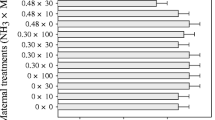Abstract
The influence of sublethal concentrations of Roundup (25 and 50 mg/l of the active compound glyphosate) was studied in the Daphnia magna Straus of successive generations. The toxic effects were assessed by the parameters of fecundity, quality of progeny, and linear sizes of daphnia, as well as by the activities of carbohydrases and proteases. The effect of the toxicant may be traced both in the parent specimens and in the specimens of successive generations. No adaptation to Roundup’s toxic impact was revealed for four generations of Daphnia magna. However, a considerable decrease in resistance to the herbicide was noted in the fourth generation when compared to the maternal line.
Similar content being viewed by others
References
Golovanova, I.L., Komov, V.T, and Kuz’mina, V.V., Influence of High Dietary Mercury Level on the Activities of Carbohydrases and Proteinases in Different Aquatic Organisms, Biologiya Vnutr. Vod, 2002, no. 1, pp. 85–89.
Golovanova, I.L. and Frolova, T.V., Influence of Copper, Zinc and Cadmium upon Carbohydrase Activities in Aquatic Invertebrates, Biol. Vnutr. Vod, 2005, no. 4, pp. 77–83.
Kalinkina, N.M. and Pimenova, I.V., An Increase in the Resistance Simocephalus serrulatus Koch during Acclimation to Increased Concentrations of Potassium Ions, Biol. Vnutr. Vod, 2002, no. 3, pp. 93–96.
Klerman, A.K., Chalova, I.V., Kurbatova, S.A., and Klain, N.P., Effect of Mineralization of Medium on Copper and Cadmium Toxicity for Freshwater Aquatic Organisms, Biol. Vnutr. Vod, 2004, no. 2, pp. 84–88.
Krivoshchekov, S.G., Leutin, V.P., Divert, V.E., et al., Systemic Mechanisms of Adaptation and Compensation, Byul. Sib. Otd. Ros. Akad. Med. Nauk, 2004, no. 2, pp. 128–153.
Kuz’mina, V.V., Biocenotic Aspects of Feeding Physiology of Aquatic Organisms, Ekologiya, 1990, no. 5, pp. 52–58.
Kuz’mina, V.V. and Ushakova, N.V., Activity of Proteinases in Invertebrates That Are Potential Objects of Fish Feeding. Effect of Temperature, pH, and Heavy Metals, Zh. Evol. Biokhim. Fiziol., 2007, vol. 43, no. 5, pp. 405–409.
Papchenkova, G.A., Study of Chronic Toxicity of the Herbicide Roundup in a Series of Generations of Daphnia magna, Toksikol. Vestn., 2007, no. 5, pp. 14–17.
Toxicological Control Methods, in Metodika opredeleniya toksichnosti vody po smertnosti i izmeneniyu plodovitosti dafnii (Method of Determination of Water Toxicity by the Mortality and Change in Fecundity of Daphnia), Moscow: Gos. Komitet RF Okhr. Okruzh. Sredy, 1999.
Ugolev, A.M. and Iezuitova, N.N., Determination of Activities of Invertase and Other Disaccharidases, in Issledovanie pischevaritel’nogo apparata u cheloveka (Study into Human Digestive Apparatus), Leningrad: Nauka, 1969, pp. 192–196.
Flerov, B.A., Gremyachikh, V.A., and Izyumov, Yu.G., Fertility and Dimensions of Ceriodaphnia affinis Lill. in a Series of Generations under the Influence of Household Sewage, Izv. Akad. Nauk, Ser. Biol., 2003, vol. 30, no. 3, pp. 375–377.
Khlebovich, V.V. and Berger, V.Ya., Some Aspects of Phenotypic Adaptation, Zh. Obshch. Biol., 1975, vol. 36, no. 1, pp. 11–25.
Anson, M., The Estimation of Pepsin, Trypsin, Papain and Cathepsin with Hemoglobin, J. Gen. Physiol., 1938, vol. 22, pp. 79–83.
Ayres, Ed., Roundup-Resistant Weeds Embarrass Monsanto, World Watch, 2003, vol. 16, no. 4, p. 8.
Cox, C., Glyphosate, J. Pesticide Reform. Winter, 2004, vol. 24, no. 4, pp. 11–15.
Hoare, K., Beaumont, A.R., and Davenport, J., Variation among Population in the Resistance of Mytilus edulis Embryos to Copper: Adaptation to Pollution?, Mar. Ecol. Progr. Ser., 1995, vol. 120, pp. 155–161.
Merivani, Y.N., Effect of Tillage, Glyphosate, and Sethoxydim on Quackgrass (Agropyron repens) in a Corn (Zea mays) and Soybean (Glycine max) Rotation (Bud Bank, Rhizome Profile, Adaptation Components, Growth Increments), Dis. Abstr. Int., 1986, vol. 46, no. 10, p. 3273.
Oozeki, Y. and Bailey, K.M., Ontogenetic Development of Digestive Enzyme Activities in Larval Walleye Pollock, Theragra chalcogramma, Mar. Biol. (Berlin), 1995, vol. 122, no. 2, pp. 177–186.
Panda, R., Rati, S.S., and Sahu, S.K., Accumulation of Zinc and Its Effects on the Growth, Reproduction and Life Cycle of Drawida willsi (Oligochaeta), a Dominant Earthworm in Indian Crop Fields, Biol. Fertil. Soils, 1999, vol. 29, no. 4, pp. 419–426.
Tsui, M.T.K. and Chu, L.M., Aquatic Toxicity of Glyphosate-Based Formulations: Comparison between Different Organisms and the Effects of Environmental Factors, Chemosphere, 2003, vol. 52, pp. 1189–1197.
Wong, C.K., Engelgardt, F.R., and Strickler, J.R., Survival and Fecundity of Daphnia pulex on Exposure to Particulate Oil, Bull. Environ. Contam. Toxicol., 1981, vol. 26, no. 5, pp. 606–612.
Zou, E., Effects of Sublethal Exposure to Zinc Chloride on the Reproduction of the Water Flea, Moina irrasa (Cladocera), Bull. Environ. Contam. Toxicol., 1997, vol. 58, no. 3, pp. 437–441.
Author information
Authors and Affiliations
Corresponding author
Additional information
Original Russian Text © G.A. Papchenkova, I.L. Golovanova, N.V. Ushakova, 2009, published in Biologiya Vnutrennikh Vod, No. 3, 2009, pp. 105–110.
Rights and permissions
About this article
Cite this article
Papchenkova, G.A., Golovanova, I.L. & Ushakova, N.V. The parameters of reproduction, sizes, and activities of hydrolases in Daphnia magna straus of successive generations affected by Roundup herbicide. Inland Water Biol 2, 286–291 (2009). https://doi.org/10.1134/S1995082909030158
Received:
Published:
Issue Date:
DOI: https://doi.org/10.1134/S1995082909030158




